The Consumer Price Index in the Philippines (2006=100) : 2017 Annual Report
- The country’s annual average inflation picks up in 2017
- The annual average consumer price index (CPI) in 2017 was recorded at 148.6 for the Philippines, 138.7 for the National Capital Region (NCR) and 151.7 for areas outside NCR (AONCR) (see Table 1).
- The national annual average inflation accelerated by 3.2 percent in 2017 from 1.8 percent in 2016. Higher annual average rates were observed in the indices of food and non-alcoholic beverages; alcoholic beverages and tobacco; furnishing, household equipment and routine maintenance of the house; transport; communication; and restaurant and miscellaneous goods and services. Moreover, the index of housing, water, electricity, gas, and other fuels posted a positive annual average growth in 2017.
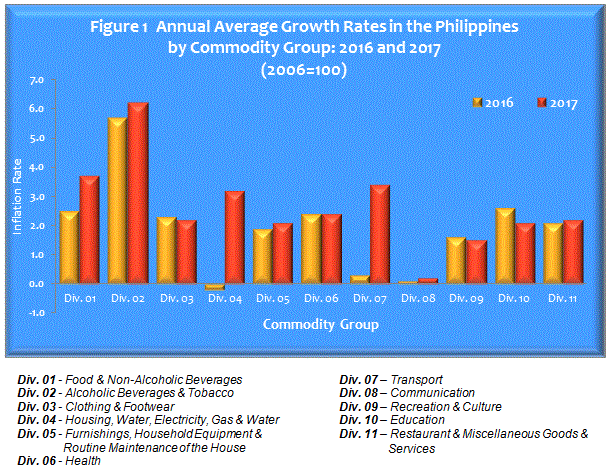
- The highest annual average inflation during the year was registered in October at 3.5 percent while the lowest was in January and June, both at 2.7 percent. (see Tables 1.1 and 2.1 and Figure 1).

- Regional inflation also moves upward in 2017
- The annual average inflation in NCR rose by 4.0 percent in 2017 from 1.2 percent in 2016.
- Similarly, the annual average inflation in AONCR climbed by 2.9 percent in 2017 from 1.9 percent in 2016 (see Table 1.1 and Figure 3).
- Compared to 2016, eleven regions in AONCR registered higher annual average inflation during the year with Region V (Bicol Region) posting the highest annual average inflation of 4.6 percent. Meanwhile, the lowest annual average rate of 1.8 percent was noted in CAR (Cordillera Administrative Region) and Region IV-B (MIMAROPA) (see Table 1.1 and Figure 2).
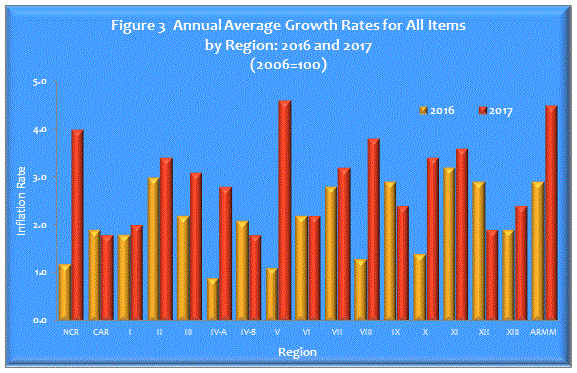
By Commodity Group, by Region
- Food and Non-Alcoholic Beverages
This year’s annual average inflation of food and non-alcoholic beverages index in NCR further increased to 5.4 percent in 2017 from 3.6 percent and in AONCR, 3.3 percent from 2.3 percent. Higher annual average rates in food and non-alcoholic beverages index were posted in nine regions in AONCR with Region V (Bicol Region) exhibiting the highest growth of 6.4 percent. Meanwhile, CAR (Cordillera Administrative Region) recorded lowest rate of 1.5 percent. At the national level, the group’s index advanced by 3.7 percent from 2.5 percent (see Table 1.1 and Figure 4).
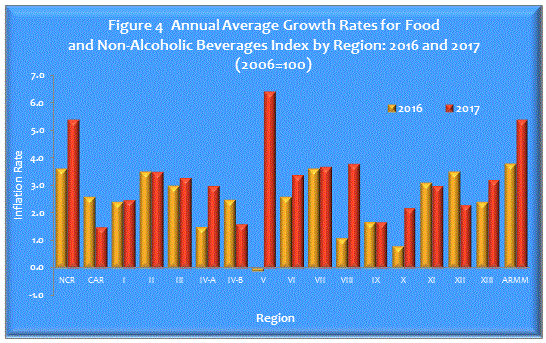
From negative annual average rates in 2016, the index of rice in NCR in 2017 inched up by 0.9 percent and in AONCR, 2.0 percent. Positive annual average growths were posted in 11 regions in AONCR in 2017 from annual average declines in 2016. Moreover, Region XI (Davao Region) and ARMM (Autonomous Region in Muslim Mindanao) recorded higher average rates during the year. The highest annual average growth in 2017 was observed in Region V (Bicol Region) at 6.0 percent while the lowest was in Region VI (Western Visayas) at 0.1 percent. The annual average change in Region IX (Zamboanga Peninsula) was zero percent. At the national level, the annual average growth of the group’s index picked up by 1.8 percent in 2017 from -0.3 percent in 2016.
The annual average increase in corn index in NCR slowed down to 11.6 percent in 2017 from 39.2 percent in 2016. The annual average increment of the corn index in AONCR was, however, faster at 1.1 percent from 0.9 percent as five regions posted higher annual average rates during the year. After recording annual decreases in the previous year, positive annual growths were also noted in Region XI (Davao Region) and Region XII (Southern Mindanao). Region II (Cagayan Valley) had the highest average annual rate of 13.0 percent during the year while Region IX (Zamboanga Peninsula) still had the lowest rate at -4.5 percent. For the Philippines, the annual average inflation of the group’s index at 1.6 percent in 2017 was slower compared with 2.2 percent in 2016.
Prices of fresh meat such as beef, pork and chicken were higher during the year. Thus, the annual average rate of meat index in NCR climbed by 5.5 percent in 2017 from 3.1 percent in 2016. Similarly, the group’s index in AONCR also moved up by 3.6 percent from 1.2 percent as all the regions posted either higher annual average rates or had positive annual average changes. Among the regions in AONCR, the highest annual average growth of 6.0 percent was registered in ARMM (Autonomous Region in Muslim Mindanao) while the lowest at 2.4 percent was seen in Region X (Northern Mindanao). At the national level, the annual average inflation of the group’s index rose by 4.0 percent in 2017 from 1.7 percent in 2016.
Unfavourable weather conditions brought about by series of typhoons that hit the country during the year generally limited volume of fish supplies in the markets. This factor raised prices of selected fish species in most of the regions. Thus, the annual average growth of the group’s index in NCR went up by 11.6 percent in 2017 from 6.4 percent in 2016 and in AONCR, 8.0 percent from 3.3 percent. The highest annual average rate during the year was posted in Region V (Bicol Region) at 12.0 percent while the lowest was seen in Region IV-B (MIMAROPA) at -0.7 percent. The annual average inflation of fish index at the country level moved upward by 8.5 percent in 2017 compared from 3.7 percent in 2016.
The annual average add-on in milk, cheese and egg index in NCR was higher at 3.2 percent in 2017 from 1.3 percent in 2016 and in AONCR, 1.9 percent from 1.8 percent as prices of milk and fresh eggs generally went up during the year. The highest annual average rate in 2017 was noted in Region VIII (Eastern Visayas) at 3.3 percent while the lowest was in Region VI (Western Visayas) at 1.0 percent. At the national level, the annual average inflation of the group’s index increased by 2.1 percent in 2017 from 1.7 percent in 2016.
With the general upward price adjustments in cooking oil, the index of oils and fats went up at a faster pace of 11.6 percent in NCR in 2017 from 3.5 percent in 2016 and in AONCR, 4.6 percent from 2.5 percent. Region III (Central Luzon) registered the highest annual average rate at 9.3 percent while the lowest was observed in Region IX (Zamboanga Peninsula) at 0.9 percent. For the Philippines, the annual average change of the group’s index accelerated by 6.0 percent in 2017 from 2.7 percent in 2016.
The annual average increment of the fruit index in NCR was slower at 5.3 percent in 2017 from a double-digit annual rate of 10.3 percent in 2016. That for AONCR, however, was higher at 6.5 percent from 5.0 percent. Eleven regions exhibited higher annual average growths with Region VIII (Eastern Visayas) posting the highest average rate in 2017 at 10.1 percent while CAR (Cordillera Administrative Region) had the lowest rate at 0.3 percent. At the national level, the average annual change of the fruit index escalated to 6.3 percent in 2017 from 6.0 percent in the previous year.
A slower annual average increase was recorded in the vegetables index in AONCR at 3.1 percent in 2017 from 11.3 percent in 2016. Thirteen regions registered either lower or negative annual average rates with Region X (Northern Mindanao) having the lowest annual average adjustment of -2.7 percent. On the other hand, the annual average growth of the group’s index in NCR at 11.3 percent in 2017 was higher than that of its previous year’s rate of 11.0 percent. For the Philippines, the annual average inflation of the vegetables index decelerated to 4.4 percent in 2017 from 11.2 percent in 2016.
Prices of sugar generally declined during the year. Thus, the annual average change of sugar, jam, honey, chocolate and confectionery index in AONCR dropped by 2.3 percent in 2017 from 4.4 percent in 2016. Negative annual average rates were posted in 13 regions with the lowest rate of -6.2 percent noted in Region VII (Central Visayas). The highest rate was, however, observed in Region V (Bicol Region) at 2.9 percent. In NCR, the group’s index posted a slower annual average gain of 2.7 percent from 4.3 percent. At the national level, the annual average rate of the group’s index dropped by 1.5 percent in 2017 from 4.4 percent in 2016.
Higher prices of condiments such as ginger and calamansi raised the annual average growth of food products not elsewhere classified index in NCR by 2.8 percent in 2017 from -1.3 percent in 2016 and in AONCR, 0.4 percent from 0.1 percent. Among the regions in AONCR, ARMM (Autonomous Region in Muslim Mindanao) had the highest annual average growth at 5.1 percent while the lowest was seen in CAR (Cordillera Administrative Region) at -5.1 percent. The group’s index at the country level posted a 0.8 percent annual average increment in 2017 from -0.2 percent in 2016 (see Table 3.1).
- Alcoholic Beverages and Tobacco
Price adjustments in cigarettes and alcoholic beverages further moved upward during the year. Thus, the annual average inflation of alcoholic beverages and tobacco index in NCR accelerated by 7.8 percent in 2017 from 3.9 percent in 2016. The annual average growth of the group’s index in AONCR went up by 6.0 percent, the same rate registered in 2016. Mixed annual movements were noticed among the regions. Except Region IX (Zamboanga Peninsula) whose annual rate remained at 6.7 percent, all regions recorded either higher or slower annual average growths. The highest annual average rate of the group's index during the year was registered in Region IV-A (CALABARZON) at 11.2 percent while the lowest at 1.9 percent was noticed in Region VII (Central Visayas). For the Philippines, the annual average rate rose by 6.2 percent in 2017 from 5.7 percent in 2016 (see Table 1.1 and Figure 5)
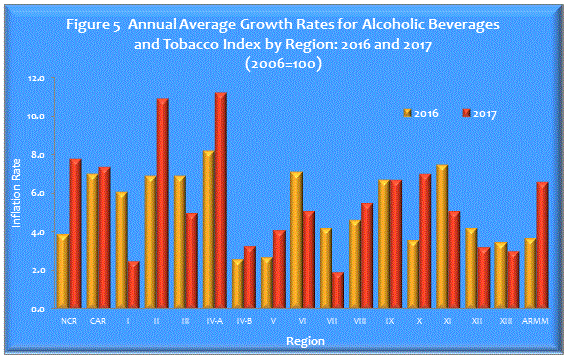
- Clothing and Footwear
The annual average movement of clothing and footwear index in NCR went up by 2.7 percent in 2017 from 2.5 percent in 2016. This was brought about by the higher annual average gains in the prices of selected clothing materials, ready-made apparel, and footwear. Higher service charges for the repair of footwear in the area were also noted this year. On the other hand, the annual average growth in AONCR eased to 2.1 percent in 2017 from 2.4 percent in 2016 due to slower annual hikes registered in the prices of clothing and footwear items. Among the regions in AONCR, the lowest annual average rate in 2017 was in Region XII (SOCCSKSARGEN) at 0.5 percent while the highest was in Region XI (Davao Region) at 4.6 percent. At the national level, the annual average hike of the group’s index decelerated to 2.2 percent in 2017 from 2.3 percent in 2016 (see Table 1.1 and Figure 6).

- Housing, Water, Electricity, Gas and Other Fuels
Prices of LPG and kerosene generally went up in all regions during the year. Moreover, charges in the electricity rates also picked up in NCR and many provinces. These factors pushed up the annual average growth in housing, water, electricity, gas and other fuels index in NCR by 2.7 percent in 2017 from an annual decline of 1.8 percent recorded in the previous year and in AONCR, 3.4 percent from 0.5 percent. Compared with their 2016 rates, all regions in AONCR posted higher annual average growths in 2017 except Region IX (Zamboanga Peninsula) and Region XII (SOCCSKSARGEN) whose annual upticks were slower this year. Region X (Northern Mindanao) exhibited the highest annual average change at 7.0 percent while Region VI (Western Visayas) had the lowest annual growth of 0.9 percent. At the country level, the annual average rate accelerated by 3.2 percent in 2017 from -0.2 percent in the previous year (see Table 1.1 and Figure 7).
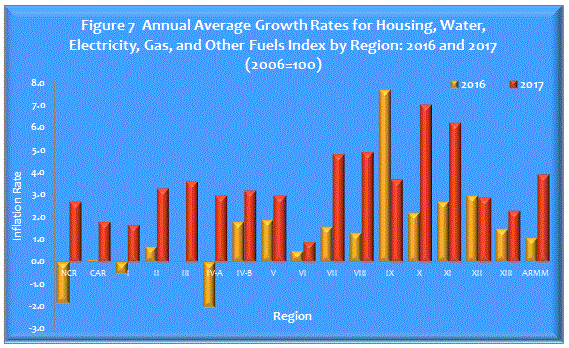
- Furnishings, Household Equipment and Routine Maintenance of the House
The annual average increase in the index of furnishing, household equipment and routine maintenance of the house in NCR was higher at 2.2 percent in 2017 from 1.0 percent in 2016. This was effected by higher prices in selected household furniture, furnishings and appliances. Higher salary for household helper in the area also contributed to the uptrend. Meanwhile, in AONCR, the annual average growth of the group’s index slowed down to 2.1 percent from 2.2 percent. Slower annual price hikes in selected furniture and furnishings, appliances and household textiles were noted in some provinces. The lowest annual average growth of 0.5 percent was posted in Region XII (SOCCSKSARGEN) while the highest rate of 4.7 percent was registered in Region X (Northern Mindanao). At the national level, the annual average growth of the group’s index eased to 2.1 percent in 2017 from 1.9 percent in 2016 (see to Table 1.1 and Figure 8).

- Health
With upward adjustments in the prices of medicines and some medical products and higher charges for medical and hospital services, the health index in NCR moved upward by 2.8 percent in 2017 from 1.3 percent in 2016. However, in AONCR, the annual average growth of the group’s index decelerated to 2.3 percent during the year from 2.7 percent in the previous year brought about by lower annual mark-ups in the prices of medicines and charges for hospital services in selected regions. Among the regions in AONCR, Region VI (Western Visayas) registered the lowest annual change of 0.7 percent during the year while Region X (Northern Mindanao) posted the highest rate of 4.5 percent. The annual average growth of the health index in the Philippines was pegged at 2.4 percent in 2017, the same rate recorded in 2016 (see Table 1.1 and Figure 9).
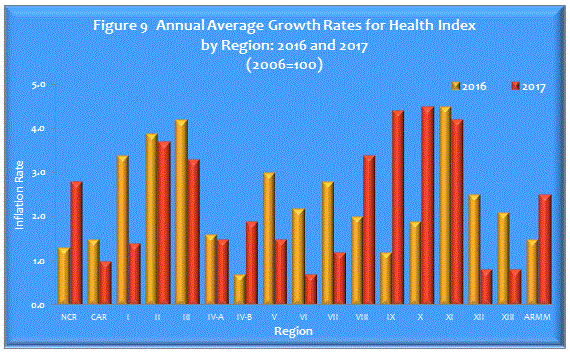
- Transport
Increments in the prices of diesel, gasoline and auto LPG and higher transport fares (airplane, ship and railway) primarily raised the annual average rate of the transport index in NCR to 6.8 percent this year from an annual drop of 0.4 percent in the previous year. The same trend was observed in AONCR as the annual average growth of the group’s index jumped by 2.4 percent from 0.5 percent. Ten regions exhibited faster annual average increases in 2017. Moreover, the annual average changes in Region IV-A (CALABARZON) and Region XII (SOCCSKSARGEN) picked up by 3.4 percent and 1.0 percent, respectively, from their corresponding previous year’s rates of -1.5 percent and -0.2 percent. The highest annual average growth of 3.4 percent was seen in Region IV-A (CALABARZON) and Region VIII (Eastern Visayas) while the lowest at 0.5 percent was in Region X (Northern Mindanao). For the Philippines, the annual average growth of the transport index climbed by 3.4 percent in 2017 from 0.3 percent in 2016 (see Table 1.1 and Figure 10).
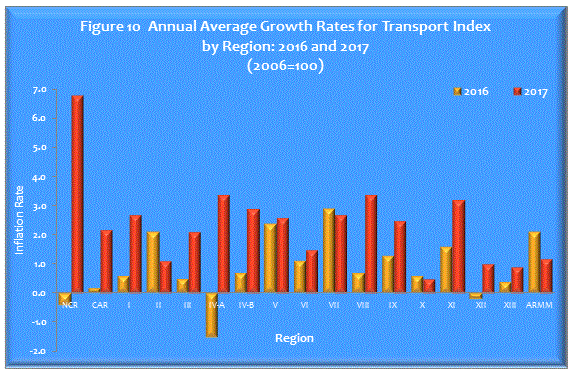
- Communication
The communication index in NCR registered a higher annual average growth of 0.7 percent in 2017 compared from 0.2 percent in 2016. This was brought about by higher charges for telephone services and repair of mobile/cellular phones. Meanwhile, the annual average movement of the group’s index in AONCR remained at 0.1 percent. Higher charges in courier services in most of the regions and price increases in cellular prepaid cards in selected province were noted during the year. The highest annual average rate in 2017 at 1.1 percent was seen in Region XI (Davao Region) while the lowest at -0.1 percent was in Region II (Cagayan Valley) and Region III (Central Luzon). The Philippines’ annual average growth of the group’s index inched up by 0.2 percent in 2017 from 0.1 percent in 2016 (see Table 1.1 and Figure 11).
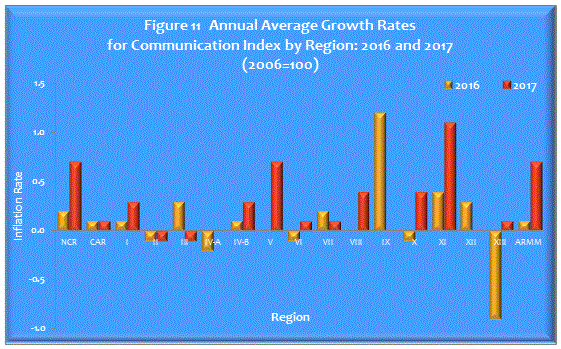
- Recreation and Culture
In 2017, the annual average inflation in recreation and culture index in NCR and AONCR remained at 2.8 percent and 1.0 percent, respectively. On an annual basis, upticks were noticed in the prices of selected recreational items and equipment. The highest annual average gain of 4.4 percent was seen in Region X (Northern Mindanao) while the lowest at 0.2 percent was in Region VII (Central Visayas). The national index’s annual average mark-up slowed down to 1.5 percent in 2017 from 1.6 percent in 2016 (see Table 1.1 and Figure 12).

- Education
The annual average hikes in tuition fees were generally lower in 2017 in many regions including NCR. Thus, the annual average inflation of the education index in NCR and AONCR both recorded at 2.1 percent in 2017 was slower compared from their corresponding annual average growths in 2016 at 3.8 percent and 2.2 percent. The lowest annual average change during the year was noticed in Region IV-B (MIMAROPA) at 0.4 percent while the highest was seen in Region VIII (Eastern Visayas) at 5.2 percent. The annual average increase of the group’s index at the national level eased to 2.1 percent in 2017 from 2.6 percent in 2016 (see Table 1.1 and Figure 13).

- Restaurants and Miscellaneous Goods and Services
The annual average inflation of restaurant and miscellaneous goods and services index in NCR picked up by 3.5 percent in 2017 from 1.1 percent in 2016. This can be attributed to price increases in meals eaten outside the home. Selected items for personal care and effects were also priced higher this year. Meanwhile, annual average inflation in AONCR recorded a slower annual average increment of 1.6 percent in 2017 from 2.5 percent in 2016 as 12 regions showed lower annual average growth rates during the year. Lower annual price upticks were observed in meals eaten outside the home and in some items for personal care and effects. The lowest annual average inflation of the group’s index at 0.3 percent was posted in Region I (Ilocos Region) while the highest at 3.7 percent was seen in Region X (Northern Mindanao). For the Philippines, the annual average rate inched up by 2.2 percent in 2017 from 2.1 percent in 2016 (see Table 1.1 and Figure 14).
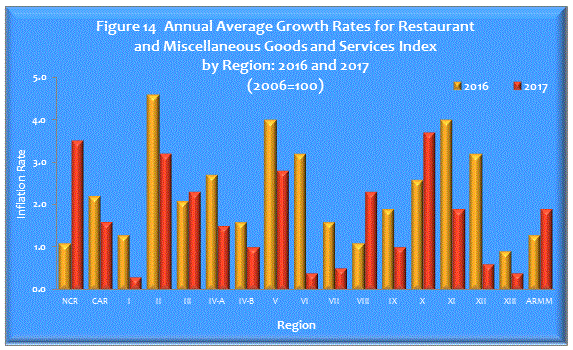
(Sgd) ROMEO S. RECIDE
Assistant Secretary
Deputy National Statistician, SSO
__________________________________________________________________________________________________________________________
CPIs and inflation rates by province and selected city are also available upon request at Philippine Statistics Authority, Economic Sector Statistics Service, Price Statistics Division (Telephone Number: 376-19-59).
